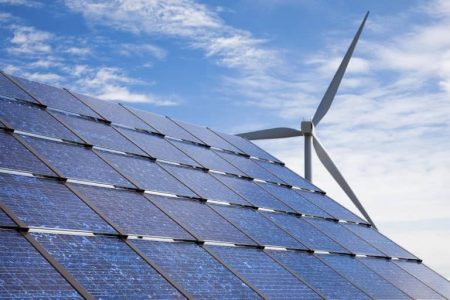March 20, 2019 – The title of this posting asks a pertinent question in our world which continues to be hungry for new sources of energy while we attempt to deal with climate change. Its author is Emily Folk, a frequent contributor to 21st Century Tech Blog. In previous postings she has looked at geothermal energy, how businesses can adapt to climate change, and how China through its Silk Road initiative is exporting carbon emissions by building thermal coal-fired power plants in other countries. Emily likes to write about sustainability and renewable energy and today’s contribution adds to her legacy of articles on the subject. You can read more of her work at her blog site Conservation Folks.
What would a future with 100% renewable energy look like?
Is it possible to get there just through wind and solar?
These questions are a source of spirited debate with not all experts in agreement. So let’s take a look at the feasibility of an energy infrastructure run purely using wind and solar power sources.
Reducing Fossil Fuel Use a Key Climate Change Goal
We know that if we reduce greenhouse gas emissions we can affect the pace of climate change. The principal method to do this involves reducing our use of fossil fuels, the principal source of human-generated carbon emissions. That’s the rationale behind developing renewable energy resources.
Currently, renewables make up 17.1% of electrical power generated in the United States broken down as follows:
- Hydroelectricity 7%
- Wind 6.6%
- Solar 1.6%
- Biomass 1.5%
Wind and solar installations have been growing quickly because with every kilowatt-hour of solar energy produced we keep 68 kilograms (150 pounds) of coal in the ground, and 136 kilograms (300 pounds) of carbon out of the atmosphere.
As we begin to see the direct impact that climate change is having on agriculture, infrastructure, forests, and the ocean, and as we witness an increasing frequency of extreme weather events, politicians, energy industry professionals, environmental groups, and citizens are looking at the possibilities of going to 100% renewable energy while maintaining reliability.
Wind and solar power are proven technologies but can they provide all the energy we need continuously on their own?
The Challenges of Wind and Solar
Wind and solar energy technologies are classified as intermittent providers. They can only produce power when the wind is blowing or the sun is shining. This means that a system consisting only of wind and solar energy production is likely to experience gaps when it cannot produce enough electricity to meet demand. At the same time, during peak wind and solar periods, the technology may produce more than peak demand requirements, a very different problem.
There are four low-carbon ways to deal with the intermittency issue and total dependency on wind and solar.
- Providers can increase capacity of both renewable energy sources well beyond peak demand. This requires massive investment in power generation infrastructure with facilities taking up large amounts of land and conceivably disrupting other forms of land use as well as the natural environment. And when the energy utility produces energy beyond peak demand it may have no way to sell it which is a money-losing proposition. One solution for dealing with excess solar and wind energy is the creation of a super grid connecting producers across vast distances. While this produces complexity to the system, for customers it ensures they have the energy they need even if in their areas the wind isn’t blowing, and the sun isn’t shining.
- Energy storage is another technology that can mitigate wind and solar intermittency. There are many different energy storage technologies to choose from including large-scale lithium-ion battery facilities, pumped water, compressed air, and flywheels. In 2018 the United States installed 311 megawatts of battery storage with deployments expected to double by the end of 2019 according to the most recent Energy Storage Monitor report.
- Energy conservation is another way to help make reliance solely on renewable energy viable. Energy efficiency is increasingly viewed today as a resource. If we can use less energy while accomplishing the same tasks it makes it easier to reduce demand for fossil fuels and makes the switch to renewable energy systems more feasible.
- Using other renewable energy sources such as hydroelectricity, biomass, and geothermal can also provide a backup to wind and solar addressing the intermittency issue. A mix of these renewables, along with wind and solar, might just get us to 100% renewable energy capable of meeting peak capacity demand. And using these additional renewables could help us save on operating costs during lower demand periods simply by turning them off.
Will We Still Need Fossil-Fuel Power Generation?
There may be a place for fossil-fuel power plants as backup to a 100% renewable energy infrastructure. Natural gas power plants are quick to turn on. Coal and oil-fired power plants, not so much. But we can continue to use these existing energy sources and eliminate carbon emissions if we install carbon capture, utilization, and storage (CCUS) technologies at these facilities.
And nuclear energy can also provide a source of carbon-free power to a 100% renewable wind and solar energy infrastructure when peak demand requires it. According to a recent MIT study, using a mix of low-carbon generation resources, including renewables, nuclear and natural gas plants with CCUS, can significantly reduce the costs and risks associated with moving to a 100% carbon-free electric power grid.









